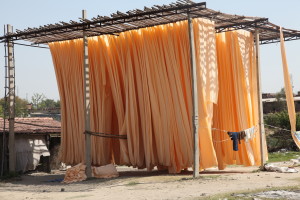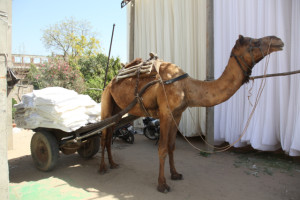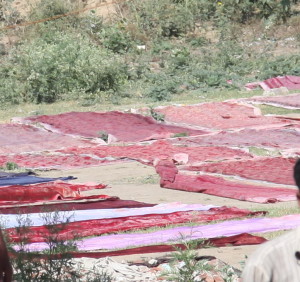Turmeric dyed cotton drying waiting to be re-dyed or printed in Sanganar just outside Jaipur on the edge of the That desert, India
A vegetal fibre, by far and away the world’s most versatile and important textile fibre–it has made and broken nations and caused not a few political furores. Cotton is thought to have originally spread from the Indus and Bengal regions to Persia, the Arab world and onwards into Europe; unsurprisingly, the English word ‘cotton’ comes from the Arabic qutn. By the 12th and 13th centuries, Italian and Swiss workshops were weaving cotton for an exclusive market, but it wasn’t until the various European East India Trading Companies that the fabric was globalised, alongside tea, coffee and spices; these sailing merchants brought back colourful painted calicoes and Palampores, which Europeans embraced in a big way, so much so that Indian production could barely keep up.
These imported cloths introduced Europe to beautifully coloured printed fabrics that could be washed. To satisfy the ferocious appetite of the new, burgeoning middle classes–the merchant class–who now had both money and a larger worldview, workshops emulating the techniques were soon established in Europe. Huge cotton mills were established in the north of England, joining Switzerland and soon becoming the most important textile producing centre in continental Europe at the time. For the first time in history, fashion was made available to ordinary people.
Cotton thrives in a subtropical climate, where there is a defined rainy season for growing and a dry season for harvesting. The fruits–the cotton boll– consist of a ball of soft, hairy fibres wrapped around the seeds, and with the right amount of water, the fibres swell and become fluffy. The cotton will be ready for harvest, around five months after planting and depending on climate and type, the cotton plant can be a short bushy 25cm (c.a. 10”) or as high as 2m (c.a. 79”) at this stage. The cotton plant yields a double crop: out of 100kg picked, around 35% will be used as textile fibre and 62% as seeds pressed for oil. The harvested cotton is dried for about 30 days before it’s de-seeded in a ‘gin’. Once twisted and spun to a soft strong thread, cotton yarns are then woven on looms into innumerable variations of cloths.
Some types of cotton fibre are hard and rough to the touch, others are silk-soft; it is usually white, creamy white and spotted, though some types produce green and green-brown fibres. Cotton is graded and traded according to colour, purity, fineness, strength, uniformity and staple. An optimum cotton-growing climate is not necessarily the right one for weaving, so cotton is often compressed into bales and shipped to other parts of the growing country or to other continents.
The best cotton with the longest and finest filaments is harvested from the Gossypium barbadense crops grown in the South Sea Islands, Egypt and the Americas. The twenty or so major cotton growing countries today include Egypt, USA, Russia, Sudan, India, the South Sea islands, Africa, China and Peru.
In the hand printing regions of Rajasthan camel labour is by far the most economical and environmentally friendly means of transporting cloth backwards and forwards between washing, drying, sun-bleaching and printing.
Environmental issues and Organic cotton
It’s clear that non-organic cotton production comes at a significant cost to the environment, its farmers and workers. To grow enough cloth for a single T-shirt requires 2000 litres () of water and 150 gms () of pesticide. I personally really don’t want to count the number of T-shirts which we have in our home alone – and that’s not counting the towels, tablecloths, sheets, bedcovers, curtain linings….
The global economy is nowadays so interlinked and interdependent that everything we buy has a consequence somewhere else. The World Trade Organisation has expressed concerns about the level of cotton subsidies paid within economically successful countries. Currently, a significant move towards making all cotton production organic is leading to real improvements across the world. Whether this will succeed depends on the willingness and the ability of government bodies to work closely with the producers, and whether we as consumers will make an effort to pay a fair and proper rate. Here are some facts illustrating why buying organic cotton really does make a difference to the rest of the world, a difference that ultimately translates back to us in sometimes surprising ways:
* Fair trade organic cotton producers have managed to reduce the industry’s water consumption by over 60% in Gujarat. This came none too soon, as the rivers throughout Rajasthan and Gujarat, so essential to all textile production, are worryingly less full than they should be and some have even dried up.
* Oxfam and Greenpeace are among western organisations starting and supporting organic production. Since 1993 they have worked in central India to provide good working conditions, above average pay, medical and health care and education projects.
* In Peru, the Native Cotton Project, backed by Unesco, supports rural artisans, Indian families and women’s projects to grow cotton on small farmyard plots. Several thousand hectares have been recovered from coca leaf production, used to make cocaine.
*Much of the organic cotton in India is grown on the hills of Andhra Pradesh Ms. Rta Chishti and Ms Vandan Shiva. To make the most of the land and to avoid the need for artificial fertilisers and insecticides, cotton is grown with food crops–lentils that nourish the soil and chilli peppers to repel insects.
Locally grown organic cotton does not have the long filament required for the finest work; instead it must be woven by hand, which produces a cloth with characteristic variations in colour, tone and fibre.
Cotton fabrics.
Suitable for the heaviest of tenting canvas to the finest baby clothes, cotton may be woven, knitted, felted, brushed or mercerised, and combines effortlessly with linen, wool, silk, rayon, lycra and many other man-made fabrics. There is a colour, weave and weight for every household use – curtains, slip covers, seat squabs, window seats, scatter cushions, tablecloths, bedcovers, sheets and pillows, towels, awnings, deck chairs, bath robes, dusters and floor rugs.
Egyptian, pima and south sea island cottons (Gossypium barbadense), cotton duck, batiste, cambric, ? bombazine, cheesecloth, chenille, chino, organdie and organza, muslin and calico, twill and drill, poplin and lawn, canvas and duck, knitted and crocheted, hopsack, basket weave, herringbone and seersucker, satin and sateen, ottoman, faille and taffeta, damask and lisere,, ticking, liquid cotton, gingham, piqué and matelassé are just some of the cotton furnishing fabrics which you will meet. Towelling, corduroy and velvet are just some of the deeper pile possibilities.
Finishing quality
Aside from the characteristics of the various fibres (for curtains and upholstering, fibre length is not as important as it is for lingerie and bedding) and chosen weaving technique, it is the finish of cotton fabrics that makes the most difference to you and me. Cotton is not the easiest of cloths to press, but if it hasn’t been finished properly at the mill it will never look good. Specialist finishes ensure the shrinkage is under control and enhance the surface texture, so that every element from cutting to pressing just feels different. The best finishers by far are in Europe–their international reputation for quality textiles, for tailoring, for couture and for home furnishings drives a serious business and keeps it so.
In our workroom, we can tell the quality of the cotton by the sound of the scissors. To test this, pick up three printed cottons: one at the top end of the scale, one in the middle and another at the lower end. As soon as you feel them, even without knowing the costs beforehand, you’ll know which is which.
Again In Rajasthan, lengths of Bagru cloth drying between print colours. These fabrics take labour and valuable water to produce. The labour for the cycles of washing and drying, dying, hand printing and hand block making is generational, local and highly skilled. The water is managed and recycled, the sun, the land and the camels do much of the other work. In this workshop, among others, the dyes are vegetal and also local.



